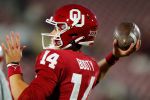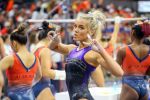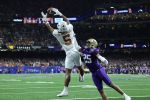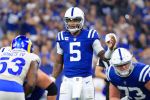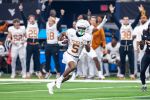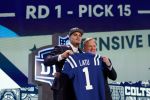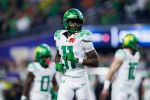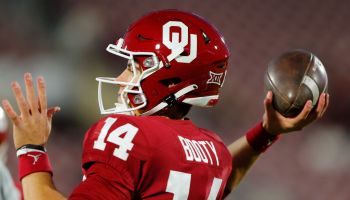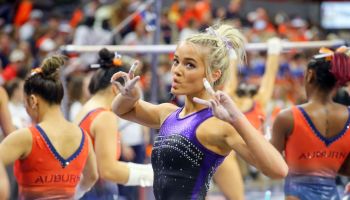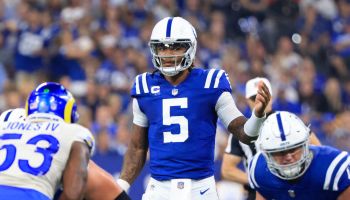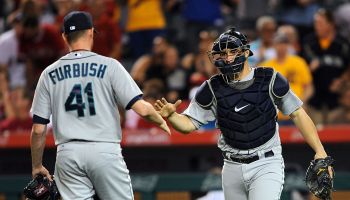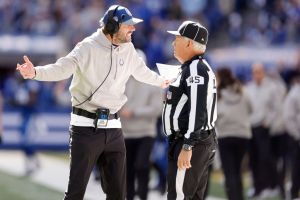
Source: Icon Sportswire / Getty
INDIANAPOLIS – Frustrated, but it wasn’t the deciding factor.
That’s how Shane Steichen viewed Darrell Baker Jr. being whistled for two costly penalties late in Sunday’s one-point loss to the Browns.
“They are tough call,” Steichen admitted during his weekly Monday Zoom call.
“I’m not going to get into a lot of the officials on that situation. As a team, we have to do better to not put ourselves in those situations at the end of games and not leave it up to those things at the end. But tough calls. They made them, and that’s what it was. We have to move on and learn from them.”
While it won’t lessen the sting, it does sound like the Colts (3-4) will be asking the NFL for some clarification on those calls.
“Yeah, we’ll look at those things. Every week we send in those things,” Steichen said.
Will the illegal contact and defensive pass interference calls against Baker Jr. be some sent in this week?
“Maybe,” the Colts head coach said, while cracking a wry smile.
Let’s examine those plays further:
Play No. 1: 3rd-and-4, Indianapolis 13-yard line, 47 seconds left
–What Happens On Play: With Browns star Amari Cooper lined up opposite (the earlier in the season benched) Darrell Baker Jr., Browns quarterback PJ Walker has his eyes locked into this matchup. Walker is clearly waiting for Cooper to execute his double move on Baker Jr., but that time is ticking with a free rushing E.J. Speed coming untouched as a blitzer. As Walker begins his throwing motion, Speed hits his former teammate and causes a fumble, which DeForest Buckner pounces on for what appears to be the game-sealing turnover. Amidst that chaos, the CBS crew didn’t spot the flag down the field, which was thrown for illegal contact by Baker Jr.
-NFL definition on illegal contact: “Beyond the five-yard zone, if the player who receives the snap remains in the pocket with the ball, a defender cannot initiate contact with a receiver who is attempting to evade him. A defender may use his hands or arms only to defend or protect himself against impending contact caused by a receiver.”
-My thoughts: This is about as bang-bang as you are going to get in terms of when the official thought Baker Jr. committed the infraction as to when Walker loses control of the ball. When you go back and watch this, it’s clear to me that the double move by Cooper leads to Baker Jr. getting off balance and losing control of his legal guarding position. The young cornerback throws up his left arm as Cooper starts to break back outside. That left arm of Baker Jr. was thrown up to initiate contact from Cooper’s re-route, and was not incidental. It was used by Baker Jr. because he was beat on the double move and was trying to recover. This is what the official saw for the illegal contact. Is it ticky tack? Probably. But there is evidence of Baker Jr. committing a foul. For illegal contact, “incident contact can occur” per the NFL rule book. For me though, this wasn’t incident. It was purposeful, with Baker Jr. knowing he was in scramble mode to recover back to legal guarding position.
Play No. 2: 1st-and-Goal, Indianapolis 8-yard line, 38 seconds left
-What Happens On Play: “On the very next step, PJ Walker is once again looking to go after Darrell Baker Jr. This time it’s a corner route deep into the end zone by Browns wideout Donovan Peoples-Jones, with Baker Jr. in zone coverage, but matching Peoples-Jones for the majority of the play. As the ball is thrown, Baker Jr. clearly grabs the right arm of People-Jones, hindering the wideout. The ball also sails about 5 yards outside of the end zone, hitting behind the yellow line that is there as a boundary for on-field photographers to sit behind during the game. A flag is thrown for pass interference, taking a 2nd-and-Goal from the Indy 8-yard line into a 1st-and-Goal from the 1-yard line.
-NFL definition on defensive pass interference: “It is pass interference by either team when any act by a player more than one yard beyond the line of scrimmage significantly hinders an eligible player’s opportunity to catch the ball. Pass interference can only occur when a forward pass is thrown from behind the line of scrimmage, regardless of whether the pass is legal or illegal, or whether it crosses the line...Permissible acts by both teams while the ball is in the air includes contact that would normally be considered pass interference, but the pass is clearly uncatchable by the involved players, except as specified in 8-3-2 and 8-5-4 pertaining to blocking downfield by the offense.”
-My thoughts: This play boils down to where P.J. Walker’s intended pass lands. And it lands a full 5 yards outside the back of the end zone. Deeming it uncatchable is accurate, in my opinion. As you see above, what Baker Jr. did (which would have been a penalty had the ball been thrown in the playing field) is a “permissible act” due to the fact that Walker airmailed the end zone by such a wide margin. This is where the 8-person officiating should have huddled together and picked up the flag, which is something they had already done twice in the game. Colts fans have a real gripe over this flag being throw and not picked up.
